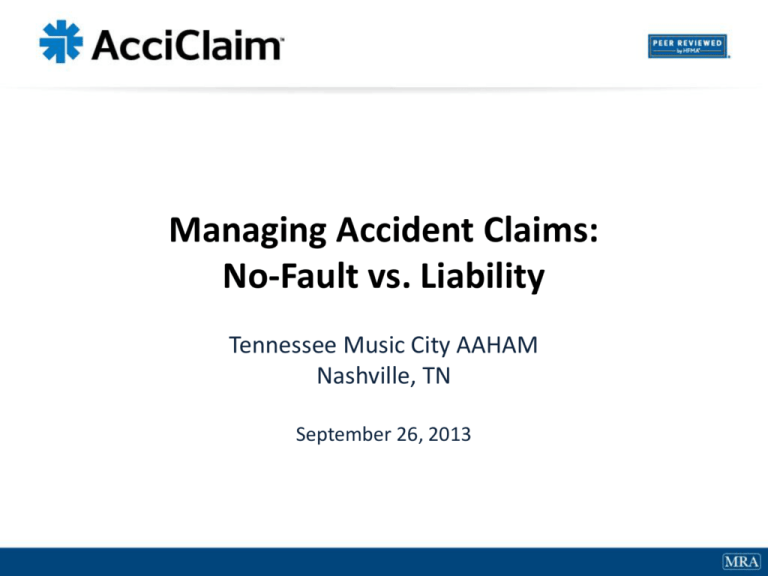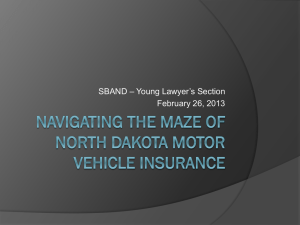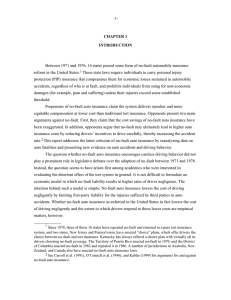ManagingAccidentClaimspptx
advertisement

Managing Accident Claims: No-Fault vs. Liability Tennessee Music City AAHAM Nashville, TN September 26, 2013 1 Chad Powers, Esq. Vice President, General Counsel Medical Reimbursements of America, Inc. 7105 Moores Lane Brentwood, TN 37027 DISCLAIMER - This publication is designed to provide general information in regard to the subject matter covered. It is provided with the understanding that the publisher is not engaged in rendering legal or other professional services. Although prepared by individuals experienced in the medical reimbursement industry, this publication should not be utilized as a substitute for professional services in specific situations. Although the individuals who prepared the publication may be legal professionals individually, such individuals are not presenting the information covered herein as legal experts in the medical reimbursement industry. If legal advice or other assistance is required, the services of a professional should be sought. 2 • Introduction − Types of insurance • Not All Automobile Insurance is the Same − − What is No-Fault insurance? What is Liability insurance? • Coordination of Payment – Why it is important to differentiate − − Pitfalls of contract language and clauses Review class action lawsuits • Conclusion • Q&A 3 Types of Insurance related to Accident Claims: • • • • • • • 4 Med Pay (No-Fault) PIP (No-Fault) Workers’ Compensation Commercial Health Insurance Government Health Insurance Liability Insurance Under/Un-insured Motorist Coverage Not all automobile insurance is treated the same: No-Fault vs. Liability 5 No-Fault Insurance: • No-Fault Insurance (e.g. Med Pay or PIP) is “first party” coverage; • Pays regardless of fault; • Pays the cost of necessary medical care received as a result of an accident 6 − Automobile Med Pay- driver, family members, passengers − Homeowners’ Med Pay- guests, not homeowners/residents − Premises Med Pay- guests, patrons, members Anyone with No-Fault insurance injured in an automobile related accident. For example: 7 • • Driver • A person driving the insured driver’s vehicle • Pedestrians with Med Pay in their car insurance policy Passengers – related or unrelated – in the insured driver’s vehicle State No-Fault Insurance Requirements: TENNESSEE: • No-fault insurance is not required. • Commonly purchased coverage: $2,000 http://www.allstate.com/auto-insurance/Tennessee-auto-insurance-coverages.aspx Liability (At-Fault insurance): 9 • Liability insurance protects the insured from damage the insured does to others or to property in an accident. • May cover: medical expenses, lost wages, pain and suffering, and attorney’s fees. • If Patient is found “at-fault” or if fault cannot be determined, liability will not cover Patient’s medical expenses Who does liability cover? • • 10 Insures the “injuring” party from… … the “injured” party’s damages claim. State Liability Insurance Requirements: TENNESSEE: • Compulsory Coverage (25/50/15): − Bodily injury: $25,000 per person and $50,000 per accident − Property: $15,000 No-Fault vs. Liability Coverage: • Liability insurance differs from other insurance policies or plans . . . • In the case of other types of insurance . . ., i.e. no-fault insurance, group health plans and workers’ compensation, the insurance has a contractual obligation to pay for medical services provided to the covered person. • Liability insurance, however, has a contractual obligation to compensate the alleged tortfeasor for any damages the alleged tortfeasor must pay to an injured party. 12 Reimbursement – 3 ways: PATIENT NO-FAULT 13 HOSPITAL LIABILITY INSURANCE Hospital From Assignment Lien ofPatient Benefits LIABLE 3rd PARTY Coordination of Payment: Why it is important to differentiate? 14 2012 NAIC COB Model Regulation: Section 3, sub. (K)(3): • “Plan” includes . . . The medical benefits coverage in automobile “no fault” . . . type contracts. • Section 6, sub. (B)(1): • When a person is covered by two (2) or more plans, the rules for determining the order of benefit payments are as follows . . . • . . . A plan that does not contain order of benefit determination provisions that are consistent with this regulation is always the primary plan unless the provisions of both plans, regardless of the provisions of this paragraph, state that the complying plan is primary. 15 TENN. R. COMP. R. & REGS. 0780-1-53: 0780-1-53-.01(1): • “The purpose of this regulation is to adopt the Model Group Coordination of Benefits Regulation, as promulgated by the National Association of Insurance Commissioners.” 0780-1-53-.02(1)(e): • “‘Plan’ may include the medical benefits coverage in group-type, and individual automobile “no-fault” … type contracts.” 0780-1-53-.02(3): • “. . . A Plan is a Primary Plan if either (a) or (b) below is true. . . . • (a) The Plan either has no order of benefit determination rules, or it has rules which differ from those permitted by this regulation. • (b) All plans which cover the person use the order of benefit determination rules required by this regulation and under those rules the Plan determines its benefits first.” 16 Contract Relationships: PATIENT HOSPITAL Express Contract: Express Contract: Liability Insurance has Quasi-contract : No-Fault insurance has a a contractual Hospital has rendered LIABILITY HEALTH LIABILITY LIABLE Express Contract: contractual obligation to pay NO-FAULT obligation to INSURANCE INSURANCE 3rd PARTY serviceshas and Patient is Health Insurance for medical services provided to compensate 3rd Party a contract withto pay for them. Patient. obligated for damages 3rd Party Patient and Hospital. must pay to Patient. 17 Contract Language – Health Insurance: PATIENT MED PAY 18 HOSPITAL HEALTH INSURANCE › Patient agrees to join insurance “network;” Insurance company agrees to pay for medical treatment. › Hospital agrees to accept payment from Insurance company as payment in full andLIABILITY agrees to only bill INSURANCE Insurance for payment. Contract Language – Health Insurance: PATIENT HOSPITAL Neither Patient nor Hospital have a contractual HEALTH relationship MED PAY with Liability INSURANCE Insurance. 19 LIABILITY INSURANCE Sample Contract Language – BCBS: Hold Harmless: Providers hereby agree that in no event, including, but not limited to nonpayment by Plan, Plan insolvency or breach of this Agreement, shall Provider bill, charge, collect a deposit from, seek compensation, remuneration or reimbursement from, or have any other recourse against Member or persons other than Plan acting on their behalf for services provided pursuant to this Agreement. http://www.anthem.com/provider/nv/f5/s5/t1/pw_b130897.pdf 20 New MRA White Paper Available MRA New White Paper – The Hidden Dangers of Liability Billing Hospitals Can Avoid the Threat of Class Action Lawsuits from the Inappropriate Billing of Liability Insurance. Get the new MRA White Paper at http://bit.ly/1eU6wSN Class Action Lawsuits for inappropriate billing of Liability Insurance represent a growing threat to hospitals across the nation, especially given the recent $17M verdict against a small 100-bed hospital. For nearly 15 years, MRA has serviced hospitals across the country providing solutions for accident claims management. Learn more at www.medicalreimbursements.com 21 Putting it Together: The Lifecycle of a Claim 22 Patient Gets Injured Hospital Treats Patient Med Pay | PIP Commercial Health Insurance Third Party Liability ACCOUNT INVESTIGATION: Bills are submitted to the carrierThe withbusiness a written office staff will submit claims to The billing office staff will communicate with For all remaining notice of an assignment of benefitsthe and/or health lien insurance carrier. Claims arebalances and/or claims patients, employers, insurance agents, adjusters, without insurance coverage(s) the so as to ensure that payments are submitted directedwith to accident details, primary subrogation and health insurance carriers, to identify all office stafffrom will investigate litigated the hospital. information, and exhaustbilling documentation payers and then bill/coordinate claims as the claims by gathering information from the all primary insurances. obtained information dictates. patient’s attorney, billing any applicable insurance carriers, or filing hospital liens. 23 Conclusion: 24 • Distinctions − No-Fault = First party insurance; pays regardless of fault − Liability = Fault based insurance; only pays if 3rd Party at fault • Relationships − No direct contract between hospital and No-Fault − No direct contract between hospital and Liability • Hospital cannot pursue liability when patient is a commercial health plan enrollee. • Recent litigation trends indicate that courts are likely to side with insured patients when hospitals pursue liability primary to health. Questions? 25 Thank You. 26






